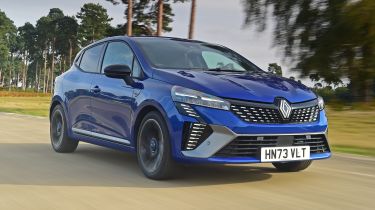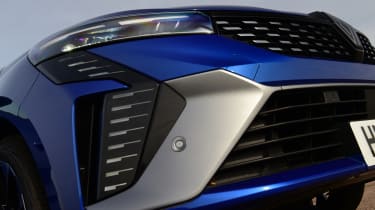New Renault Clio 2023 facelift review: stylish French supermini gets a striking new look
A new look and some changes under the skin aim to keep the Clio at the top of the supermini class

Verdict
The already-excellent Renault Clio has been given a sharp new look to match the French brand’s latest offerings, with this mid-life facelift turning the faithful supermini into a serious head-turner. A few more interior tweaks wouldn’t have gone amiss, but the Clio is as fun to drive as ever, able to skillfully balance agility and comfort, and the E-Tech hybrid is in its element around town, where its electric motor does most of the work.
The Renault Clio hardly needs an introduction, but it deserves one nonetheless. The supermini has been around for 33 years, with more than 16 million sold worldwide in that time, including 1.3 million in the UK alone. The current fifth-generation Clio has proved to be among the very best in its class since it was introduced in 2019, and is a three-time winner of our Supermini of the Year award.
However, more recently Renault has started to introduce its next generation of cars, including the all-electric Megane E-Tech hatch and Austral hybrid SUV, while the new Rafale coupe and Scenic E-Tech electric SUV have been unveiled and are heading our way in 2024. And of course, there’s the reborn Renault 5, also primed for a launch next year.
Used - available now
So in order to prevent the Clio from looking a bit old hat, next to its newer, shinier stablemates, Renault has given its hugely important supermini a comprehensive facelift.
The Clio was a relatively handsome thing before, but the facelifted model is arguably the sharpest-looking supermini on the market right now. Its striking new look takes some of the more distinctive styling cues from equally eye-catching Megane and Austral, such as the ‘F1 Blade’ in the front bumper and vertical daytime-running lights. There’s also a redesigned Renault logo that sits proudly in the heart of the grille, while the rear has been given a new set of tail-lights, plus aerodynamics elements in the bumper to emphasise the car’s width.
In case you’re wondering, the rather fetching 17-inch diamond-cut alloy wheels on our test car are exclusive to range-topping Esprit Alpine trim – a new addition to the Clio line-up. Range-topping cars like these also get a contrasting ‘F1 Blade’ and unique badging, plus some French tricolours hidden throughout the cabin.
Speaking of which, the Clio’s interior hasn’t changed all that much as part of the facelift. On the plus side, that means it’s still simple and logical, with big, chunky dials for the climate controls, and physical piano-style switches for everything else – including ones to turn off the lane-keep assists, rather than having them buried in sub-menus, as in some of this car’s rivals. There are some hard scratchy plastics dotted around, but on the whole the finish is polished, and build quality feels solid. The interior is now completely leather free too, with all but the base model utilising bio-sourced and recycled materials instead.
The downside of this older cockpit design is that it lacks the wow factor of the Megane and Austral’s interiors, not to mention their sensational Google-powered infotainment system. We found the previous-gen set-up running on our Clio’s 9.3-inch touchscreen (lower-spec models get a seven-inch display) fairly laggy and not nearly as intuitive. Thankfully, it’s now even easier to bypass, because wireless Apple CarPlay and Android Auto connectivity is standard across the range.
Esprit Alpine modes also come with a wonderfully sharp 10-inch digital driver’s display that’s responsive and can be customised to a decent degree, with different layouts for the three drive modes.
However we’re not totally sold on the bucket seats that come with the range-topping trim; the large side bolsters do stop you rolling about through the corners, but slightly wider individuals can feel like they’re being squeezed by them.
As before, there are two powertrains available in the Clio; the pure-petrol TCe 90 pairs a turbocharged 1.0-litre three-cylinder engine with a simple six-speed manual gearbox, or you can get the E-Tech hybrid driven here, which is a lot more complicated. Under the bonnet of the Clio E-Tech is a 1.6-litre four-cylinder petrol engine, working together with an electric motor that can drive the front wheels, plus a starter generator to help fire up the engine when it’s called into action.
Those motors are fed by a tiny 1.2kWh battery, which allows the E-Tech to run in EV mode for short distances. There’s no official range figure, but Renault claims you’ll use the electric motor up to 80 per cent of the time when driving in town. We hardly ever noticed the engine chiming in while we were pottering around city streets, especially in the ‘B’ mode that activates the regenerative braking to help keep the battery topped up.
The Clio E-Tech always uses the electric motor to pull away from a standstill, so the car feels responsive and pretty zippy away from the traffic lights. It’s really only beyond 20mph when the engine comes to life, seamlessly taking the reins from the electric motor. The transition back and forth between petrol and electric power is almost undetectable, with the two working together to provide a smooth linear power delivery.
However the set-up can falter under hard acceleration, as the transmission likes to take its time deciding when it’s going to change gear, often leaving you stuck listening to the roar of the engine. The hybrid Clio isn’t particularly quick anyway, taking over nine seconds to hit 62mph, so we’d recommend adopting a gentle approach with the throttle.
Once the powertrain settles down, the Clio E-Tech is comfortable at motorway speeds and you’re kept nicely isolated from harsher imperfections in the road surface. There’s fun to be had on twistier roads too, thanks to direct, well weighted steering and just a hint of body roll as you chuck the Clio into corners.
Renault says the hybrid can return up to 67.3mpg, and while we couldn’t match that figure, we did manage to average 55.2mpg on a journey that included towns, motorways and a couple of spirited blasts on back roads.
Regardless of which version you pick, the Clio offers appealing value for money. The Clio E-Tech in particular currently starts from £21,295, or £229 per month on PCP finance with a £3,579 deposit.
Standard kit on base Evolution cars includes 16-inch alloy wheels, a seven-inch digital instrument panel, a seven-inch touchscreen, wireless smartphone connectivity, LED headlights, rear parking sensors and active safety systems like lane-keep assist and lane-departure warning.
Mid-range Techno trim brings a more aggressive front bumper, a reversing camera, a wireless charging pad for your smartphone, and larger alloy wheels, while the top-spec Esprit Alpine gets all the goodies, including the larger driver’s display and touchscreen, aluminium pedals, heated front seats and steering wheel, and even more safety kit.
| Model: | Renault Clio E-Tech Hybrid Esprit Alpine |
| Price: | £24,095 |
| Powertrain: | 1.6-litre 4cyl petrol, 1x e-motors |
| Power/torque: | 143bhp/205Nm |
| Transmission: | Six-speed automatic, front-wheel drive |
| 0–62mph: | 9.3 seconds |
| Top speed: | 112mph |
| Economy: | 65.7mpg |
| CO2: | 97g/km |
| On sale: | Now |















